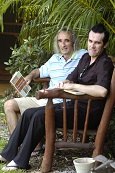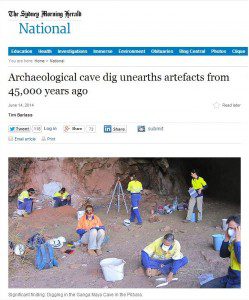By Steven Strong
Contributing Writer for Wake Up World
I recently received a phone call from Original elder Eddy McPhee, thanking us for the work done in lobbying for a feature article published in Sunday editions of the Sun Herald, The Age and Canberra Times about the impending destruction of the ancient Maya Ganga Cave in the Pilbara WA.
After exhausting every ‘official’ channel of objection, Eddy had contacted our team, hoping there was some way to breach the long standing impasse he encountered with the media. Following my 11th June article for Wake Up World, Mining Operation Continues 300 Metres From Ancient Maya Ganga Cave, the Sydney Morning Herald published an article entitled Archaeological Cave Dig Unearths Artefacts from 45,000 Years Ago three days later.
The way Eddy saw it, after years of no interest, finally the cave’s archaeological importance and hints of its impending desecration were on the public register.
I wasn’t so impressed.
Ironically, at the same time Eddy rang, I was trying to cobble together a set of excuses and apologies that could explain how dramatically altered the final version was from what SMH senior writer, Tim Barlass, had described. Ultimately the June 14th article represented only a small percentage of the archaeology discussed and emailed between Tim and I, and if I had known in advance what the final edit was to be, I would never have agreed to contribute to such a one-sided pro-mining report.
Blow It Up!
The initial investigation and subsequent archaeological paper commissioned by Atlas was completed some time ago, in April 2013. But despite finding artefacts over 45,000 years old, until we became involved, no-one but Eddy was banging the drum with news of the oldest site yet found and the enticing prospect the site could reveal even older artefacts. None of this reached the public ear and no-one was listening, printing or even mentioning that potentially the oldest known occupied site in Australia could be blown up for a mine. And that crucial point was discreetly lost in translation in the final draft fashioned by the editorial staff at the Sydney Morning Herald.
There is a real possibility this ancient site could already be destroyed; the mining company’s intention to detonate the fragile sandstone at the rear of the cave was freely shared with me by the company representative while I stood beside the cave’s entrance. And this cultural and historical insult was supposed to be the major thread of the SMH article – and was the only reason I alerted mainstream media in the first place. But in the final article, the idea of mining closer to the sacred cave is only implied. What was never directly stated was how close “closer” would be, what the actual nature (and chemistry) of this possible “disturbance” would be, or what had potentially already been destroyed by the existing mining operation.
At no stage in the flimsy SMH article is discussion of this “disturbance” quantified or expanded upon. Somehow I think describing a huge explosion in relatively brittle sandstone at the rear of an ancient Original site might be a touch too realistic and graphic – however accurate – for the complacent mainstream reader, whereas a minor disturbance makes for a much more palatable read.
A List of Omissions
What was also missing in the final version was Tim’s welcome announcement last week that a professor “from ANU” was on side and prepared to supervise archaeology on that site in a way that gives due respect to the Original custodians of the land. Tim was justifiably excited, knowing that an academic of such stature was prepared to conduct archaeology backed up by talent, experience and respect to Original sensibilities. But alas, when came the time for the final edit, all news of this academic, including his valid concerns that the archaeology conducted was low grade and the urgent need for intervention, had been discarded.
Apparently such details aren’t ‘newsworthy’.
Also lost in inconvenience was the written response Tim asked me to send to him earlier that week. Understandably he wanted me provide a balanced perspective to a news release from Atlas Mining, at least attempting to avoid writing an article that merely parrots the mining-company line. But again, it was perhaps too real or complex for mainstream news.
Primarily my statement was a repackaging of our position: The notorious English divide-and-conquer legacy reign supreme in these exchanges. One, sometimes two, rogue Original families are enticed to sign off on the mining approval, and it’s all legal – done and dusted. The rest of the community who disagree are deemed merely trouble-makers and people of ‘dubious’ character. We already know that the parties who signed off are considered to be in the minority, but were the claimants aware of or did they acknowledge that there was another tribal group who also lay claim to custodianship of this site? That being the case, how can any person or corporation claim to represent the rightful party, until issues of custodianship are resolved?
As requested by Tim, I provided a response to Atlas’ news release. The undeniable difficulty in dealing with the rightful claimant was but one observation I tended. I also reminded Tim more than once of the importance of the minimum and continual human occupation date in the Pilbara being no less than 47,000 years; this extremely ancient occupation date does not sit comfortably with any Out-of-Africa theory dependent upon people sailing into Australia’s east between 50-60,000 years ago.
What did astound us was that through unfathomable leaps in logic, Tim managed to find a suitably qualified ‘scholar’ to downplay the historical significance of these findings. Clumsily, Dr. Kate Morse, an employee of Big Island Research and one of the archaeologists who undertook the on-site assessment, attempted to qualify that human entry into the Pilbara region – the part of Australia nearly every expert believes to have been settled last – could have taken place immediately after the ‘Out of Africa’ model suggests modern humans first set foot on these ‘foreign’ shores.
At this stage, both the archaeologist and the journalist have shown themselves to be out of their depth. Nobody, until now, has made such a claim that the Pilbara was one of the first regions settled by Africans stepping off the theoretical boat. All theories that propose Africans settled Australia between 50-60,000 years ago also present an agreed pattern of subsequent habitation. Entry into the Pilbara was only recently and begrudgingly accepted to have been first inhabited as much as 25-30,000 years ago, once all coastal areas and locations near major rivers were populated. Dr. Morse’s assessment that a 45,000+ year old occupation was the result of a direct landing party from south east Asia is at worst contradictory, and at best an utter revelation – and one way or the other, should have been reported as such.
The Pilbara was (and still is) so infertile and inhospitable that its arid landscape lends weight to the proposal that it was only settled after all other areas in Australia had exceeded their carrying capacity. But a minimum date of 47,000 years of continuous presence beginning so soon after Africans theoretically arrived? It just doesn’t make sense. Why would sea-bound settlers forsake the comfort of familiar coastal resources and landscapes and head for such trying and foreign conditions as the Pilbara?
Consistent with an emerging pattern, the content of this conversation was omitted from Tim’s final article.
Present and Future Tense
What I am earnestly assured of is that the mining company complied with all legal procedures applicable to it, and has been granted the “right” to continue provided it limits any “disturbance to be no closer than 50 metres from the cave entrance”. And this is where the journalist Tim failed in his journalistic duty; to question why mining work still continued regardless of the site’s discoveries.
The most blatant omission was that there is no admission of explosives and detonations being planned as close as is possible to the cave’s entrance. The managing director was correct in stating his case in the present tense in that the “cave was not affected in any way by the mining operations,” and cunning in not mentioning directly their intentions to explode nearby in the very near future. He spoke of the “50 metre buffer zones”, and their intention to hold “further meetings”, but nothing as disturbing as explosions 50 metres from the cave’s entrance was discussed.
I have stood inside the cave and I certainly agree with Kyle (the company representative who took us on site) that the cave ceiling is very unstable and liable to fall. It is the most fragile cave I have seen; so much so that I made sure not to stamp my foot or brush against the walls while inside. You don’t need an expert to state the obvious: any explosion, be it 50 or 250 metres away, will be felt here, threatening the archaeological integrity of this historic, unexplored site and its surrounds.
At Sometime Something Might Take Place
“Sometime in the future” seems to be the common thread in the rhetoric surrounding this site. Further excavation “planned in the near future”… “is part of Atlas’ intention to establish all the facts in respect to the Ganga Maya. This process, which is being funded by Atlas, is ongoing”. Now 15 months since the first excavation, what is promised is essentially that, at an undisclosed time, Atlas will “establish the facts” that determine the future of the site based on their own pre-determined agenda.
Atlas representatives admit that the cave is a “very exciting find” but don’t explain why, apparently not prepared to concede that it is potentially the site of the earliest human settlement. Kate Morse, the spokesperson for the archaeologists, Big Island Research, pointed out that they “would prefer to get other dates” before being so bold. But it seems there has been a dereliction of archaeological duty; as “exciting” as this archaeology is, no paper has been submitted to any scientific journal, nor did archaeologists approach any media or government outlet with news of this ancient site over the past six months. Since the release of this mining report, nothing more has been said, planned, published or excavated. There has been no mention made of what work is intended next, no date given as to when they are to convene, and no worthwhile commentary published about the site’s implications to our understanding of how Australia was settled. We, not Atlas, contacted the Sydney Morning Herald; Atlas and Big Island representatives certainly weren’t speaking to the media by their own volition, nor did they mention any talk of future explosions in their interviews.
Why did they choose to keep these findings out of the public gaze? Do they wish to conceal them? Or do they just not understand their importance?
Original Rights
According to locals, a public meeting is apparently to be held at sometime in the future, as a part of Atlas’s “ongoing” yet going nowhere approach. Based on recent history, who will be invited and what will be tabled for discussion is now a concern to many community members. But there are even bigger issues yet to address.
Yes, different groups within the Nyamal/Nayal tribe are at loggerheads over this approval. But what was not considered when formally applying for this mining permission is that another tribe also lays claim to this site – and were never recognised or consulted ahead of the mine’s approval. Beside the Nyamal, whose self appointed representatives have cooperated with the mining company, the Gariera tribe are adamant that the ancestral rights to the disputed land are theirs.
The determination of tribal ancestry must be settled before any process of ‘Original approval’ can legitimately be undertaken.
The Gariera peoples’ absence from the preliminary approval process negates all that follows, because until the claim of ownership is rigorously assessed one way or the other, nobody can sign this land off on behalf of anybody.
Inadequate Journalism
After providing SMH with 6 photographs taken on the site, at Tim’s request, plus another two of Eddy, Tim chose to select only standard issue photographs from Atlas Mining Company. Knowing as we do that this is a very sacred men’s site, and of the protocols required, the photograph of three women standing inside the cave – none of whom had Original permission to enter – really does highlight the incompetence and insensitivity of the archaeologists in control. Atlas’ intention to continue down this path is therefore a pointless gesture.
I would have thought completing what was started, digging more pits and testing more artefacts, was essential to any “future” plans. But “the future” has been happening for over a year now, and their work so far is patently insufficient.
The next course of action is a no-brainer: dig more pits, with a much greater scope of Original people and archaeologists involved. Atlas claim they harbor a desire “to establish all the facts in respect to the Ganga Maya”, but with only one pit excavated and no specific recommendations on the digging of a second or subsequent pits, or just as importantly, public acknowledgement of other connected sacred sites, I see no evidence of good faith or competency in their investigation. While such work might involve halting operations in the vicinity of the ancient cave, Atlas can’t seem to be very specific in their plans, apparently needing more time in quite reflective silence before taking any action.
In Search of “All of the Facts”
With only one pit successfully excavated and the second adjoining pit abandoned due to self-imposed time constraints – over a year ago – the fact that officials are now declaring that “this process… is on-going” seems somewhat contradictory.
Atlas Mining Company maintains that it is committed to establishing “all the facts”. So let’s examine them…
Less than 2% of the site has been studied, and while the archaeology conducted has shown itself to be lacking in sensitivity and vision, the site revealed evidence that is at least 45,000 years old, potentially the oldest known in Australia. The site is also connected to ancient Dreaming tracks and other sacred sites. Everyone agrees more examination has to be done, and yet nothing has happened. The investigation into this sacred site did not adhere to Original cultural practices and standards, thus causing great offence. And the mining operation continues to inch closer to the already unstable ancient cave.
Atlas Mining and Big Island Research appear to have the same goal – to facilitate mining. There are other connected sites and caves nearby; if the mining company’s Original supporters have any connection to the land they claim to represent, Atlas and Big Island Research must know this to be so. But, adopting the Maya Ganga Cave as their archaeological ‘poster child’, they have disregarded this knowledge and shown no interest in exploring any further than the ancient Cave itself.
These facts are well known and already on the table. Now, amid talk of impending explosions and novices visiting the site, Atlas and Big Island representatives appear more than happy to let all talk of this sacred ancient site disappear into the background scenery.
So Many Unanswered Questions…
Why did the company/archaeologists who made such ancient discoveries make no attempt to publish the results and methodology in any scientific journal for scrutiny? Or notify mainstream media outlets? Or advise the relevant Government agencies? Or continue their investigation, if only for the sake of intellectual curiosity?
If this is an “on-going process”, why has all archaeology on these sites, and academic research/follow up work, apparently ceased since the initial investigation conducted 15 months ago? Why even bother going through the motions of collecting data and analysing archaeology if nothing is done with it?
When will “in the future” take place, and who will be invited to participate?
What about the contributions of the supposed Nyamal tribal representatives who supported the mining application? Why are Atlas and Big Island representatives unaware that some of the other surrounding sites they have seen and mapped are interconnected to Ganga Maya through Lore and Dreaming stories? Why is no Dreaming story related to Ganga Maya, or any context of the Cave’s function, included in their report?
Is Atlas or the mining industry regulator aware that another tribe has laid claim to this site, and how do they intend to respond to this situation?
Most importantly, does Atlas intend to explode “behind” and “beside” to within 50 metres of the fragile cave’s entrance?
Dear Tim Barlass
It is not just one mining company, a family of disputed Original representatives and a few franchised archaeologists who contributed to this situation. The grotesque culture created by this country’s political officials and mining industry magnates is undoubtedly an elemental part of this mess. And what is most disappointing in all this is that, Tim Barlass, working for one of the few supposed bastions of ‘free press’ and independence, has ultimately chosen to reproduce the mining company’s rhetoric instead of really questioning the situation.
Tim, you told me of the professor’s endorsement and offer of assistance. I was more shocked than you. Did he leave the country, die or retract his offer? You made it clear you thought this was a huge step forward in our understanding of Original history, but within a day, you published an inadequate discussion of the implications of these findings, contradicting what you said hours earlier.
Tim, in your final article, there wasn’t a mention of a tom-thumb cracker, sparkler or even a rogue flame being lit in the area, and no question of how effective a 50 metre buffer might actually be. And although those involved have been entirely reactive or silent on the matter until now, your article was presented in fashion that suggests this archaeology is recent and was freely shared by Atlas and Big Island representatives.
Tim, showing a photo of three women working inside a sacred men’s cave was a mistake. This is culturally offensive to the Original tribal people and should be apologised for. That is the kind of error you make when taking directions from the wrong people.
Tim, before your article was published, I told you that I doubted this story would be covered in the mainstream in an unbiased manner, and Tim, you said all the right things to allay my concerns… then push came to shove.
Is this journalistic integrity? Or is your work clouded other imperatives?
What is more than a touch ironic is that the Sydney Morning Herald proudly carries the banner of “Independent. Always.” I must have missed the fine print which excludes mining companies, regulators and contractors from serious scrutiny.
I expect no more from the mining companies and mainstream political organisations, but I naively hoped that with such an important discovery, the writers at Fairfax would deem it newsworthy to discuss world-changing archaeology and the threat posed to it – and the Original peoples – by a short-sighted mining operation. After all, the Herald claims to champion the attitudes and concerns of the centre-left and left constituents… but obviously that is not the case.
When it comes to Australia’s mining racket, it seems nothing and no one – not even the “free” and “independent” press – will dare question them.
Oh wait up… Isn’t Gina Rinehart a major shareholder of the Sydney Morning Herald? And doesn’t she also have a mining lease in the same region?
Why did we even bother?
About the authors:
 Steven Strong is an Australian-based researcher, author and former high school teacher. Evan Strong is a researcher, historian and author with a Bachelor degree in the Social Sciences. Their work is to explore the ancient story of the Original people, a narrative that was almost lost to aggressive European colonisation.
Steven Strong is an Australian-based researcher, author and former high school teacher. Evan Strong is a researcher, historian and author with a Bachelor degree in the Social Sciences. Their work is to explore the ancient story of the Original people, a narrative that was almost lost to aggressive European colonisation.
Editing and additional commentary by Andy Whiteley for Wake Up World.
This article © Wake Up World.

If you've ever found value in our articles, we'd greatly appreciate your support by purchasing Mindful Meditation Techniques for Kids - A Practical Guide for Adults to Empower Kids with the Gift of Inner Peace and Resilience for Life.
In the spirit of mindfulness, we encourage you to choose the paperback version. Delve into its pages away from screen glare and notifications, allowing yourself to fully immerse in the transformative practices within. The physical book enriches the learning process and serves as a tangible commitment to mindfulness, easily shared among family and friends.
Over the past few years, Wake Up World has faced significant online censorship, impacting our financial ability to stay online. Instead of soliciting donations, we're exploring win-win solutions with our readers to remain financially viable. Moving into book publishing, we hope to secure ongoing funds to continue our mission. With over 8,500 articles published in the past 13 years, we are committed to keeping our content free and accessible to everyone, without resorting to a paywall.




